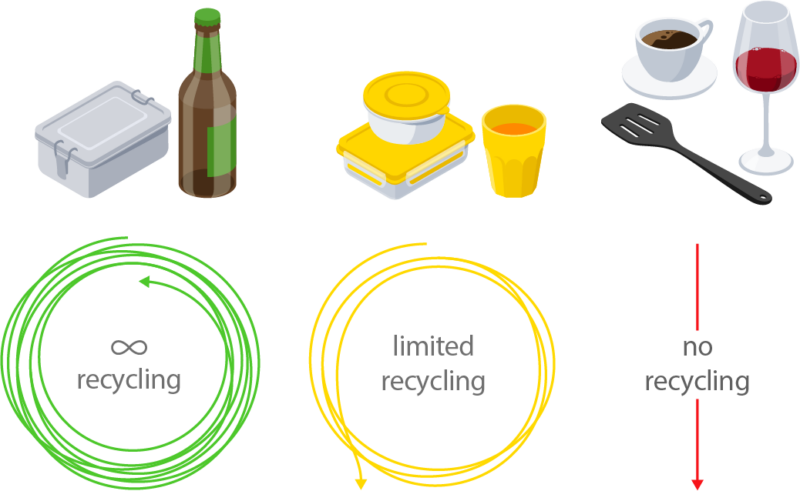What is reuse?
Reusable foodware and packaging are repeatedly used for the same purpose for which they were originally created. Their stability and material properties allow them to be cleaned and hygienically reused many times.
A minimum number of reuse cycles is needed to achieve the breakeven point that compensates for the impact of their production and use.
Reusable products are ideally designed and used with multiple environmental and human health impact areas in mind. This includes climate, water use, chemical safety, and end-of-life impacts.

Climate
The greenhouse gas emissions associated with a reusable product are highly correlated to the energy and resource intensity required for production and cleaning, its weight in combination with the mode and distance it is transported, and the ability of recycling at end-of-life to prevent the use of virgin materials. Unlike single-use products, reusables require additional transport and washing cycles that should be considered to minimize climate impacts.

Water use
In addition to the water required for production, reusables need to be washed after each use. To minimize the water needed to operate a return-based reuse system, high-efficiency machines and reuse of washing water can help to minimize water use. Keep in mind that in some geographic areas, water for washing may be a limited resource and result in higher local environmental impacts.

chemical safety
Glass, metal, ceramics, and plastics are materials commonly applied in reusable food packaging and foodware, whereas paper and many multilayer materials are not suitable for reuse. Migration of chemicals from foodware and packaging into foods occurs from all different materials, but the extent strongly depends on the material’s properties and its chemical complexity. The stability and inertness of a material over its lifetime and under all possible use conditions are other factors affecting the chemical migration into foods. The ability to absorb chemicals during use and release
them during subsequent reuse cycles also impacts
chemical safety.
Whereas the properties of permanent materials such as glass and stainless steel do not change over extended periods of use, plastics can be chemically modified by exposure to heat, UV, and oxygen. Handling of reusable plastic foodware and packaging can also change the chemistry of the material, for example, by cleaning, microwaving, and abrasion. These factors lead to increased migration of a variety of different chemicals from plastics, such as degradation products, additives, and residuals from previous uses, such as dishwasher detergents.

end of life
After many cycles, eventually all reusable products will come to the end of their life. This may be due to breakage or quality defects, and the number of reuse cycles that can be achieved depends largely on the durability of the material and careful treatment during use, cleaning, and distribution.
Ensuring reusable products are fully recyclable can help to minimize impacts at their end of life. Recycling permanent materials such as steel, glass, and aluminum is infinitely possible. Recycling for non-permanent materials such as plastics is limited since their physical-chemical stability degrades over time and virgin material will be needed to maintain their strength. Some inert materials, such as ceramics, porcelain, and crystal glass, are not recyclable.

infrastructure
Reusable food packaging most often has lower impacts than single-use packaging, but not in all cases. To achieve minimal impacts, reach reuse targets being set by businesses and governments, and provide the most benefit to society and the environment, significant investments may be needed in infrastructure as well as in standardization and legal adjustments.
The infrastructure needed may depend on whether the reuse system being implemented is based on a refill model where the user cleans and refills the product themselves on-site, or if it is based on a return model where the user gives the used product back to a business to externally clean and then refill and redistribute.
Investments can include creating refilling stations for users to easily operate as well as efficient external washing facilities and transport networks to collect, clean, and redistribute the product. Users should be educated on how to properly use the system as well as incentivized to stay engaged in using it.
standardization & legality
Standardization across large geographic areas is ideal to allow reuse system operators to share containers and return bins. This provides greater convenience for users, lowers the costs for operators, reduces transport, and increases certainty for businesses transitioning to reuse. Regulatory agencies may need to identify whose jurisdiction reuse falls into and play a larger role in providing oversight and guidance to further enable reuse, address questions of liability, and ensure food safety is maintained.

social and cultural aspects
For a reuse system to be successful, the social and cultural contexts in which it will operate should be considered. Everything from the physical distribution networks involved to the education of users might need to be designed to match the societal norms, lifestyles, and infrastructure available. For example, a return-based model using highly centralized washing facilities and truck transport might work well in an urban area, but it may not be a good fit for rural communities not connected by a high-speed road network. Instead, there a more localized and distributed refill-based system could work better. For some communities, sharing and reusing containers may come easily to them, whereas others will be less comfortable with the idea and benefit from more reassurance upfront about convenience and safety.




